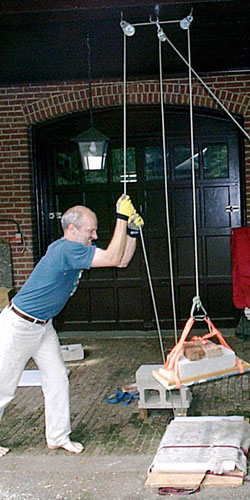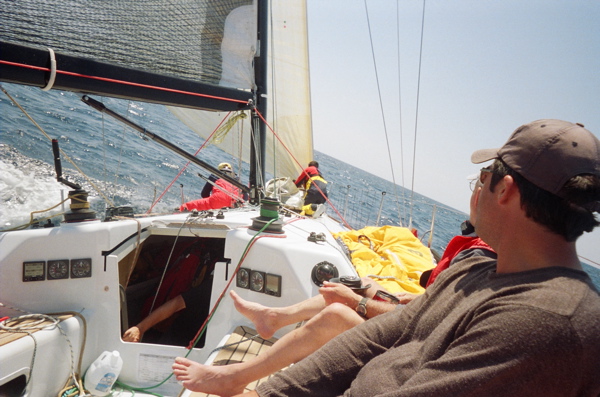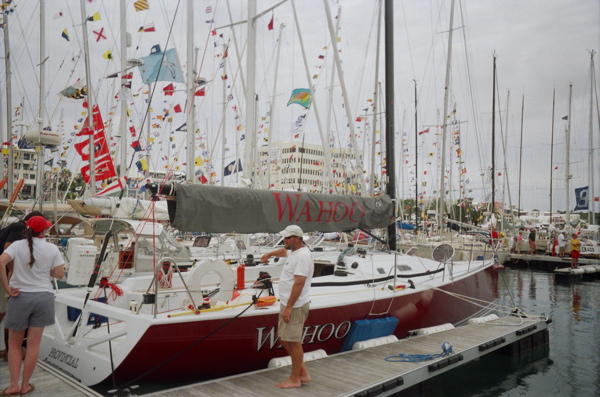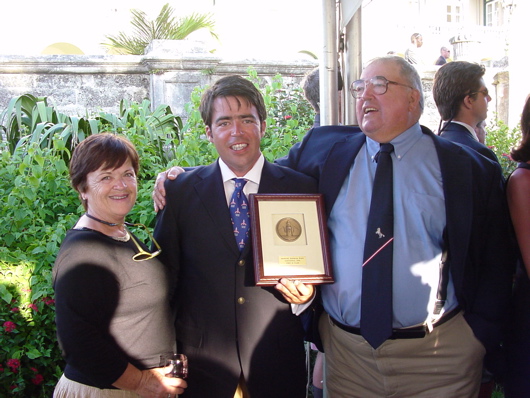 Bin
Ruiter Participates in Classic Sailing Race: Newport-to-Bermuda Bin
Ruiter Participates in Classic Sailing Race: Newport-to-Bermuda
By Bin Ruiter
By some amazing stroke of luck, I was asked to participate
in the Newport-to-Bermuda sailing race which started
June 16, 2006. While I had sailed a fair amount in
my life, I certainly did not feel qualified for the
race but my friend assured me I’d be fine so
I agreed to go. Growing up as a obsessed windsurfer
and having done some sailing, including a few years
of racing, I had always heard of this classic sailing
event but never thought I’d find a boat crazy
enough to take me along, especially not on this special
Centennial Race celebration. After it was all said
and done, we finished first in our division and had
a glorious ride down to Bermuda.
In short, there were
about 270 participant competing in 16 different classes.
Our class contained 17 other boats and we were by far
the shortest with some of the others being almost twice
as long. Since all boats are different, they are rated
and finishing times are adjusted accordingly; so a
shorter boat might get there last but then some of
the larger boats may “owe” you
x amount of minutes or seconds per mile thus equalizing
the field.
The distance
to Bermuda is about 635 nautical miles (735 miles or
1,176 Km) from Newport, Rhode Island to Bermuda. The
rhumbline (start/finish straight line) is roughly 162
degrees magnetic, which means a S-SE course. In the
middle of the course is the Gulf Stream, the main obstacle
and challenge of the race. The Gulf Stream is a river
of fast traveling water that travels the globe and
which brings along unpredictable local weather and
spins off warm and cold-water “Eddy’s” (large
swirls of current).
 The "blister machine"
The "blister machine" |
Our boat, the WAHOO, is a 41.5 foot long boat designed
by John Corby. Basically a hot-shot boat built entirely
out of carbon (no metal or wood on the boat except
for some shackles, etc.) Like all race boats, the only
design consideration is speed and performance. As a
result, the cabin is small, space is limited, and the
remaining spaces are not always the most comfortable
or convenient. We carried a 10-person crew split into
two groups plus one floater (nav person). I had met
all but four of these people when I raced with them
a few years ago.
Upon learning
I was going on this trip, I knew I had to get up to
speed on all levels. I started by building a device
(a.k.a. the "blister machine") to build up calluses
on my hands while doing some upper body exercises.
And then for a few weeks, I reduced my diet some and
lost a few pounds. Finally, I went through all my books
to touch up my knowledge of sailing terminology, boat
parts, knots, etc. I was as ready as I was going to
be, especially considering I had not been on a boat
in a couple of years. In order to get familiar with
the boat and to help the owner out, I spent three days
with the owner’s
son working on the boat in the weeks preceding the
race. There is a 22-page checklist that boats have
to comply to in order to pass the mandatory safety
inspection before you are allowed to participate in
the race.
In the week preceding the race, we got word from the
first Hurricane of the season hitting the USA. As a
result, the weather forecasts were all over the map
which made preparing and packing difficult. Normally
you would just pack for all weather conditions but
space and weight on the boat are at such a premium
that you are not allowed to bring anything you don’t
anticipate having a need for. The last forecast I remember
hearing was that the race was expected to be cold and
wet. As a result, I made a last minute purchase of “foul
weather” gear
in the event these guys were right. They were not.
On the Wednesday preceding
the race, my neighbor and I left for Rhode Island.
Luckily we had a mutual friend in Newport so we wouldn't’t
have to sleep on the boat with the rest of the crew
before the race. While we had Thursday and Fri morning
carved out to do some practice sails, it became evident
that this might not happen upon seeing the boat. There
were tools everywhere along with long lists of things
that still needed to be fixed. Things like awaiting
the arrival and installation of new lines (ropes),
wind vane, short wave radio, etc. So we spent Thursday
and Fri morning getting the boat ready.

A chart dating back to 2004 showing
the location
of the Gulf Stream and
accompanying Eddy's. |
On Friday morning,
the skipper and navigator went to an exclusive weather
meeting. They signed up for a personalized weather
forecast which was presented on the morning before
our start. While they received the latest wind and
current info, one of our crew loaded the boat with
our provisions. It is amazing how much crap you end
up bringing for 10 hungry people for 4 days. When the
navigators came back, we had a brief team meeting and
it became clear that this race would be unique. The
exactly location of the Gulf Stream, it’s Eddy’s, as
well as the projected path of the low pressure systems, following a tumultuous
week in which Hurricane Alberto came and left, made for difficult navigating.
At the meeting they discussed that this might be the year of going East, insinuating
that even though sailors rarely win taking the easterly route, the conditions
were such that this year they might.
Our skipper and navigators decided that we
would neither go West nor East and that we would proceed
on the shortest path (rhumbline) until new weather
developed or an obvious option would present itself.
In the end, this turned out to be a great move. On
Friday morning we left and the Race for our class and
division started at 2 pm. Starts are staged according
to division/classes in 20 minute intervals. Certainly
anyone seeing us leave the dock would not have guessed
we would have had a chance to do well in this endeavor
as we were missing some key pieces of equipment (wind
gear), some safety stuff (we opted to use a satellite
phone rather than SBB), etc. And while individually
mostly experienced, many of the crew had never sailed
together.
We had a good start hitting the line on
time and away from others. Almost immediately you saw
the others in our class either veering down heading
East or pointing high heading West. Within a few hours
all the others were gone from sight and we were all
alone. While some of the larger boats have on-board
radar, it is rare for the smaller ones like us to carry
this so you have to be constantly on the lookout for
objects in the water and other boats.
Our crew was split into
two teams of four/five and one floater. We instituted
what is called the Swedish
Watch system whereby you do 6 hour shifts
during the day (2) and 4-hour shifts at night (3).
So 6am-noon, noon-6pm, 6-10pm, 10pm-2am, 2am-6am,
etc. Because there are only 3 shifts at night, you
end up shifting your shifts around every day. Morning
shift one day, afternoon shift the next, etc. Clearly
the 2am-6pm is the hardest to stay awake and the
afternoon shift is the hardest to sleep because it
is so warm.

Sleeping on the boat is hard.
Above Burt shows how it's done
surrounded by luggage,
coolers,
gear and always on an angle. |
Speaking of sleeping, getting
sleep is a hard thing to do in a race. You can only
sleep on one side of the boat because of weight considerations.
Two of the three eligible comfortable bunks (the ones
you can adjust to level your bed) are filled with luggage.
What remains is one bunk and then some surfaces deep
inside the hot boat pitched at 30 degrees or more and
you are surrounded by unbelievably loud noises as sails
are trimmed or changed. Plus the motor runs from time
to time to charge the batteries (used for fridge and
nav systems). Any time there is a sail change, everyone
is on deck helping out. Eating time, and in my case
food prep time, comes out of your sleeping time. And
during the day, especially in light wind conditions,
it was simply too hot to sleep. Now that is is all
over I can state that if you are sleep deprived enough,
sooner or later you will be able to sleep anywhere.
Saturday was absolutely glorious day of sailing. The
wind was perfect. The waves were low-key. The temperatures
were perfect. We put up the big reacher sail and were
making awesome time cruising at roughly 10-15 knots.
During the day, we say a tuna or two jump out of the
water. Flying fish were all around most of the day
and we also were accompanied by some dolphins throughout
the day. At some point during the day, the water turned
a true blue rather than a greenish blue. Sat night
I realized that I had not seen as many stars since
I was a 10-year old kid living in a remote area in
the middle east. I realized I had pretty much forgotten
what a star filled sky looked like. Unbelievable! The
other fun thing at night was to watch the iridescent
algae behind the boat that lights up like small streams
of light.
Within each watch the roles were fairly defined. Out
of the four people on our watch, two of them took turns
driving/steering and the others helped trim the head
and main sails. One of the four worked the very front
of the boat in case of sail changes, another worked
the mast (to hoist the new sails and to help collect
and fold sails that are taken down). Especially at
night, driving and trimming sails is hard as you cannot
see the telltales or the pressure in the front of each
sail. We quickly discovered that one of our crew excelled
at driving at night and did not need as much guidance
from people lighting up sails and reading instrumentation
values back to him. He apparently had spent a ton of
time sailing little dinghies and practiced doing so
with blindfolds all the time. It showed as he did very
well and it made our evening watches much easier and
relaxed (since we didn’t have to do as much work).
Sunday the winds started
to ease just as we were trying to pierce through the
fast moving currents of the Gulf Stream. While normally
you can expect to do 90-degree tacks (turns), because
the current was pushing our bow ‘down river’,
we were actually doing close to 190-degree turns. And
then when you measured your speed you see that while
your speed over the water isn’t too bad,
you realize that when measured over land, you are going
backwards. No need to say there were a lot of arguments
on the boat and disbelief that we couldn’t
point the boat any higher into the wind in either direction.
After some time, and monitoring the water temperatures
to figure out how close we were to the stream’s
edge, we made it through and started making progress
again.
That
night we heard some reports on the nightly race broadcast
that large metal objects were sighted at specific locations.
These are usually large freight containers that fall
of ships and then circle the globe in the gulf stream
until they sink. It was a good reminder to keep your
eyes peeled ahead and practice in your head what you
would do in the 10-20 seconds it takes for your boat
to sink in the event we hit one of those. A little
late to go digging for essentials at that point...

A pic I found on the web of a
Manta ray
(minus the
sucker fish ours carried) |
On Monday morning we started seeing some boats again.
Since they were too far for us to see their sail numbers,
we assigned them nicknames. As the day progressed,
we realize that were were sailing among the big guys
and were feeling good about our performance. But we
still had a long way to go. Winds were still pretty
light in the a.m. At some point, a fin appeared behind
the boat. Then another. At first we thought it was
a shark or two, maybe dolphins. But as soon as it became
light enough for us to see, we realized it was a Manta
Ray. It was as wide as our transom, about 10 foot wide,
with two large sucker fish attached. A beautiful creature
that is very flat, wide and which move so elegantly
through the water. What a treat.
On Monday late afternoon, we could see Bermuda along
with some thunderhead clouds. It is amazing how local
weather is and I never realized this until seeing the
clouds hover over and along the gulf stream and now
over and surrounding the island of Bermuda. That little
strip of land (coral reef actually) is heated during
the day and as a result, weather systems form directly
overhead and in the area. It wasn’t long before we found ourselves in the middle of a downpour
and thunderstorm. Unfortunately we made a tactical error during the storm by
going through a sail change rather than stay inside the storm and benefit from
the increased winds for a while. We easily gave up several spots by not tacking
into the storm for a while. So after the rain stopped, we found ourselves in
a lull when four or five competitors passed us in the storm.
We finished by midnight
on the North East of Bermuda. It was fascinating to
me that after not seeing any boats for three days straight,
we ended up short tacking with many of them at the
end of the race. After we finished, we were confident
we had done well but would not find more until the
next day. As it turned out, we were 34th to cross the
line meaning we beat a bunch of much longer boats and
after adjusting for time under IRC ratings, we came
in first in our class.

WAHOO (and Allen) in the Bermuda
Yacht Club's Winners
Circle. |
After finishing we headed for
shore as fast we could. We were all exhausted. Navigating
is tricky around Bermuda because of all the coral reefs.
We safely docked behind a giant cruise ship but then
we realized that that part of the shore was gated and
part of the cruise ship facilities. We then moved our
boat to a fuel doc in front of the cruise ship and
behind another and raced into Saint George’s
looking for liquor. We made a critical error in Newport
not packing some rum or beer... Unfortunately the town
was dead by the time we got there so we headed back
to the boat for some sleep. By the time I woke up,
I was amazed to find that both cruise ships had managed
to leave without waking me up. Both these monsters
were at least 8-10 stories high and we were parked
squarely in between and within 50 feet of either of
them. Scary...
As soon as we woke up on
Tuesday, we headed down to the middle of the island
to Hamilton Harbour. That is where the yacht club resides
and where people were meeting us. On our way down
we left our guard down for a bit and promptly ran
aground scraping the keel and probably removing a few
pounds of lead. Too bad the depth gauge wasn't working
and our navigator was catching up on some Z's...
Upon arrival, we were
sent to the dingy club where we spent the rest of the
day cleaning the boat. Once we found out we had won
our division, we realized that we’d be moving
the boat to the yacht club’s “Winner’s
Circle” the next day; all the people who attend
the extravagant parties that ensue for the next three
days, are able to check out the boats that competed
and excelled in the race. After cleaning the boat it
was finally time for a much needed shower to scrub
off days of suntan lotion, goo and whatever else. All
I can say is thank god for all the wicking, plastic
clothes that keep you from stinking up the place after
a few days of hard work and no showers! And almost
as nice as the showers was being able to sit on a chair.
After a few days on the boat, you are unable to get
comfortable anymore and "boat-but" starts to set it.

Burt, Rick, Jan and Gus
exploring
the island by means of rented scooters.
|
The next day
we all rented scooters and zipped along the island
at 30 mph or so. A little confusing to be driving on
the other side of the road especially around traffic
circles et all. I found out afterwards that 25% of
tourists land up in a crash before they return their
scooters. I don’t think any of the
WAHOO crew landed up with scrapes or dings. After the second day of chores, we
finally had some time to take a dip. All this time on the boat and even two days
after and we finally got to take a dip. The water was awesome. It wasn’t
until I emerged from the water and looking at the horizon that I realized that
sailing to some place is a funny way of getting there. The experience didn’t
really hit me until after I went swimming in the ocean for a while.
The next
few days were spent exploring the island and attending
a crew dinner and various yacht club events. From dawn ‘til dusk we drank “dark ‘n
stormies” a concoction of Gosslings dark rum and ginger beer; enough to
level even an ‘experienced’ gin martini guy like myself.
On Friday,
exactly a week after the start of the race, my neighbor
and I left by plane to Newark, NJ. From there we took
the train back to Philly. While two of the crew returned
the boat, the 8 others returned by plane, all of whom
probably too exhausted to be of much use in returning
the boat anyway.
All in all it was
a grueling event but well worth the effort. I would
have gladly traded some of the periods of light wind
for something on the verge of out of control. But everyone
assures me that once you find yourself in nasty weather
it will leave you longing for the light stuff. Hopefully
I will have another opportunity in the future to decide
for myself.

Minutes before the start. Going over assignments and
some safety reminders.

The gun sounds and we're off along with 16 other boats
in our division.

Almost immediately, many headed East (above) while others
took the Westerly route.

The rest of my watch: Rick, Gus and Jake.

Gus at the helm while Jake and Rick attend to a sail-change
on the bow.

The members of the other watch: Mike, Burt, Allen, Matthew
and Bo.

Bin Ruiter comes up for air while preparing a crew meal.

A picture of a Manta ray similar to the one we encountered.

We encountered some periods of slow winds.

The finish is on the NE part of the island while the
YC is in Hamilton.

WAHOO in the "Winners Circle" at the prestigious Bermuda
Yacht Club.

The entire crew: Mike, Henry (owner), Gus, Matthew, Bo,
Jake, Rick, Allen, Jan and Burt.

Taking a break from scootering to enjoy the sights.

Finally taking a dip.

Gus accepts his well-deserved trophy and plaque.

The Fretz'es: Joanie, Gus and Henry.
For additional pictures of the boat, the race,
and
so on, please visit mostlyweb.com/wahoo
<- go to the last page | old
news reports (pre 2008) » | current news » |

